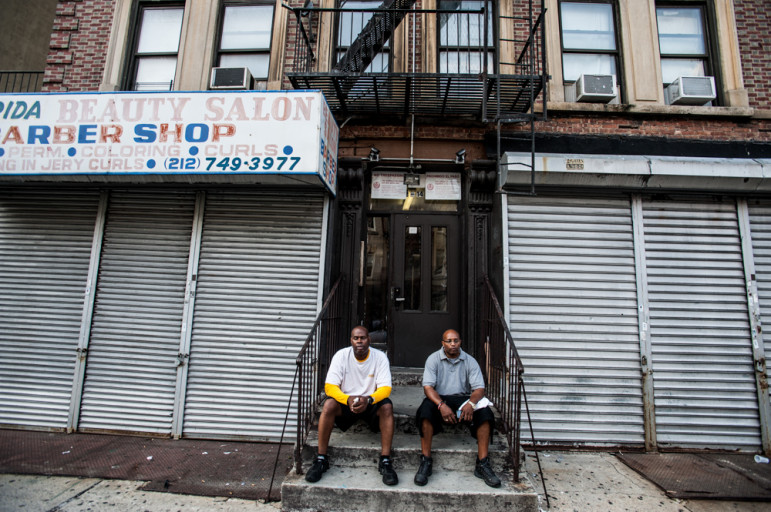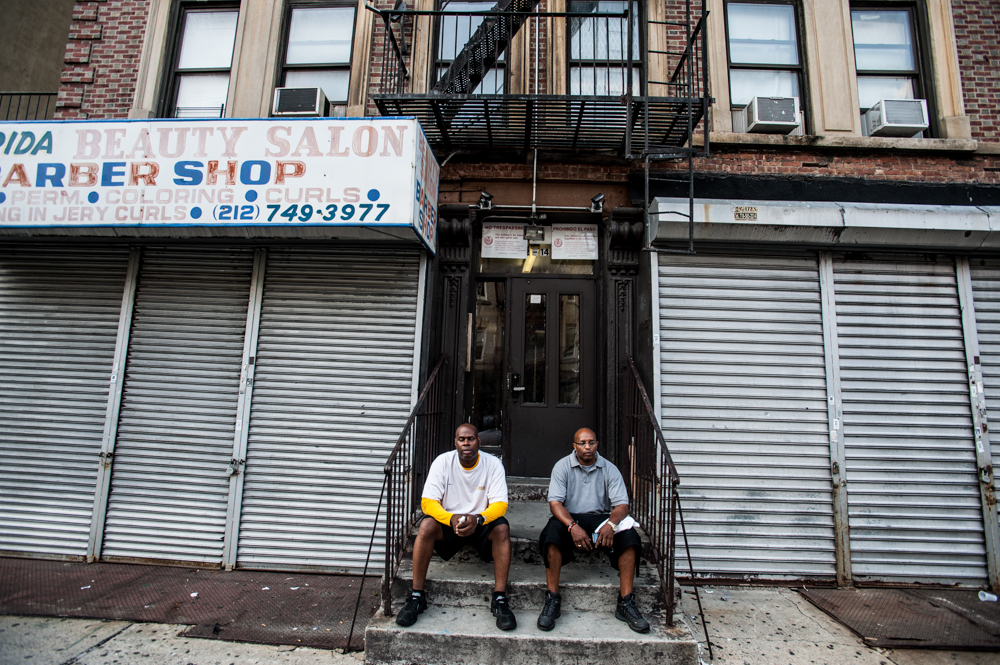
Robert Stolarik / JJIE
Derrick Haynes (left) and Taylonn Murphy sit together in West Harlem in this August 2013 photo.
NEW YORK — It was early August, exactly two months after the largest raid in New York City history at the Grant and Manhattanville housing projects, when 20 people, mostly older folks, crammed into the Community Board 9 office in a tiny storefront in Harlem.
Domino’s boxes were spread across the table and every chair was filled. A woman rocked her twin babies in a double stroller. Another poured Coke from a 2-liter bottle into cups and passed them around.
Derrick Haynes addressed the group.
“We want to get our kids back,” Haynes said. “But what are we bringing them back to?”
The group was made up of parents and relatives of those arrested — the raid resulted in the indictment of 100 young people from the neighboring housing projects. The group included family members of victims of the violence that had escalated since the death of Tayshana “Chicken” Murphy, a basketball star who was 18 when she was murdered in a hallway of the Grant Houses in 2011.
Residents and law enforcement officials say it was her slaying that enflamed a long-running feud between the rival houses, leading to retaliatory beatings, stabbings and fatal shootings.
 Chicken’s father, Taylonn, was there. So were people from the neighborhood who didn’t live in either Manhattanville or Grant, and a couple of people who had traveled from across the city for the meeting.
Chicken’s father, Taylonn, was there. So were people from the neighborhood who didn’t live in either Manhattanville or Grant, and a couple of people who had traveled from across the city for the meeting.
One of those people, Monica Cassabery, is a community activist from Queens. Her son was murdered three years ago, and since then she’s made it her mission to educate families on the toll violence takes.
“Y’all are blessed,” she told the group. “I understand that your children are incarcerated. My son was murdered, shot in the back, and I will never hug him, touch him, speak to him again.”
She told the group how important it is to be involved in their children’s lives and not let them slide into the life of the streets. If not, she warned, they may lose their children to the same kind of violence that took her son.
“I would not want for any of you to join that club,” Cassabery said. “It’s the worst club in the world.”
That first meeting was full of emotion. One woman got up and left, tears falling, as Cassabery spoke. Many expressed frustration at the parents in the community, including themselves, and outrage at the police, whose raid was still rippling through the community as court dates loomed and their children’s futures remained uncertain.
Murphy and Haynes, who led the meeting, encouraged the group to spread the word and get people involved in making their community safer.
“All we need is people to come,” Haynes said. “We gotta take this group and start banging on people’s doors.”
Murphy stressed that solutions that came from inside the group, and not outside intervention, would be what made a lasting impact on the community.
“This isn’t about anybody using this platform to get their point across,” Murphy said. “This is for the people who have to live here every day.”
Two weeks later, the group, with some new faces and minus a few of the old ones, met outside Community Board 9’s storefront and walked several blocks to the West Harlem Development Corporation for a meeting with Kofi Boateng, the corporation’s director.
They came with a lot of questions. They’d heard there were millions of dollars allotted to making improvements in the houses that weren’t being used. Some had questions about who was running the community center that had recently opened after being shuttered for years. And many wanted to know what concrete things the group could do to make a difference.
Boateng confirmed that WHDC was given $3 million by Columbia University for the express purpose of improving life at the Grant and Manhattanville houses. A committee was formed, made up of the presidents and other officers of the tenant associations of both houses, to decide what the funds should be used on.
The committee hadn’t made much headway, though. Ann Morris, Manhattanville’s tenant association president, was dealing with the recent murder of her 45-year-old son and wasn’t going to be able to work on the funds anytime soon.
“There is no reason to have problems rising when we have the resources to solve them,” Boateng said. “Let’s go talk to the families and the youth and see what they want. From there it’s much easier for us to design solutions.”
So the group hatched a plan.
There will be a big meeting Saturday where the residents of both houses will air grievances and make suggestions for how the money should be used. Boateng asked the group whether the meetings for Grant and Manhattanville should be held separately.
Taylonn Murphy spoke up.
“The point we’re at now, we need to come together,” Murphy said. “There’s too much separate right now. This is a 40-year-old rift on and off. Until we are able to see things eye to eye, we’re going to have the same issues.”
Most of the group agreed, and the decision was made to plan one meeting for the two houses, with 300 people expected plus the press.
At a final planning meeting before the event, a sense of purpose was in the air. Boateng passed out shirts with “West Harlem Development Corporation” on the front to people who volunteered to pass out bag lunches, collect surveys and usher people from lunch to the focus groups. Those groups would be split according to age, with young people from both houses in one area, and older residents in another.
“It’s very important that we show outsiders that this is our community and we care about what happens here,” Boateng said. “We are the ones who are going to make a change.”

Pingback: Harlem Raid Families from Both Sides Make a Plan - roxanna asgarian